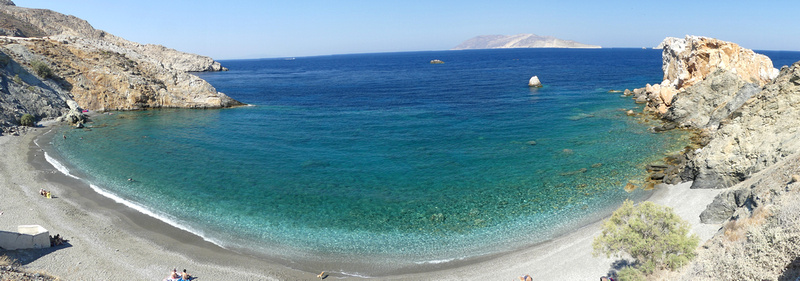


Summer 2019 Part 5 - Marseille, Cassis, amd Nimes France, July 2019
MARSEILLE
Marseille is Frances second largest city (population 869,000) after Paris, France's largest port, and the oldest city, having been founded by the Greeks in 600 BC.
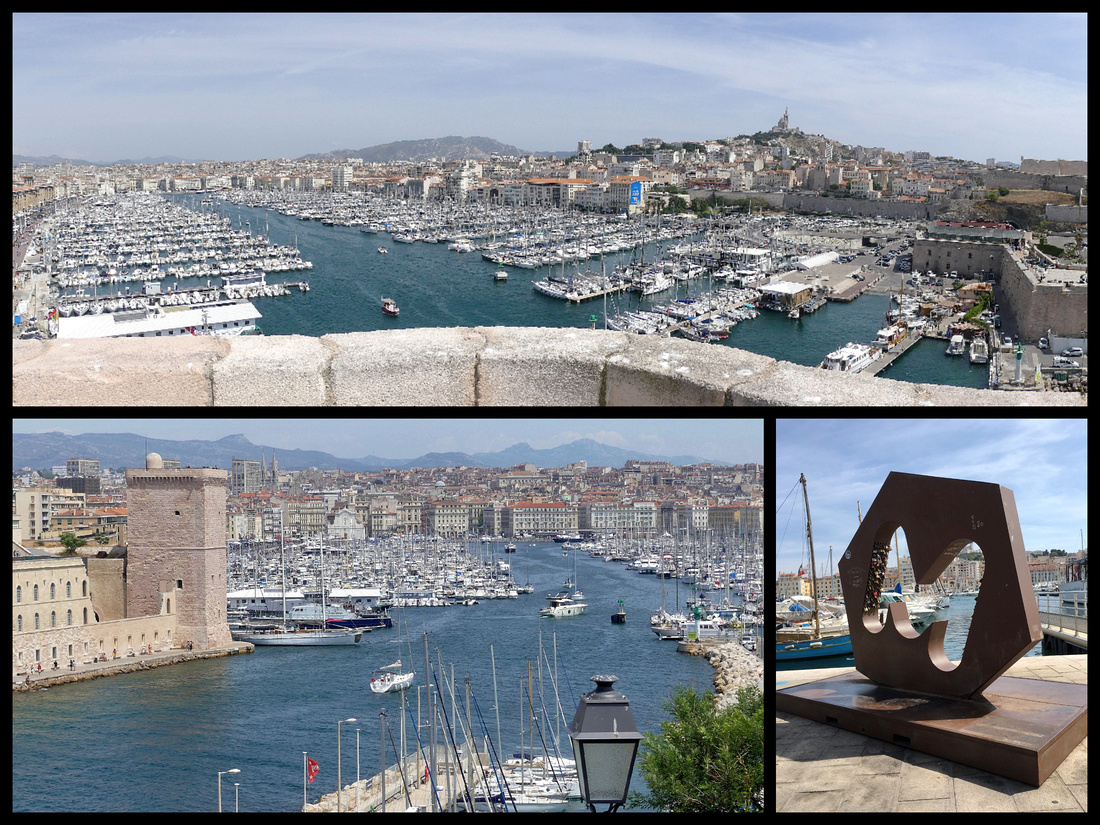

I arrived in Marseille at the main train station, Gare St Charles, a beautiful 19th century station (but totally modern inside, bright and clean). As you exit there’s a view of the city below you and a ‘monumental’ grand staircase – art nouveau with gorgeous lampposts and statues and palm trees. At the bottom of the stairs Boulevard d’Athenes is a bit gritty but lively with every imaginable ethnic market and eatery, the aroma was exotic and enticing. Short walk to La Canebiere, the main thoroughfare that runs down to Vieux Port. And then there’s the port, really huge for an ‘old’ harbor. Rectangular shaped with a wide promenade on three sides and full of every imaginable kind of boat. Marseille has the feeling of a combination of Palermo, Genoa, Athens, Paris and New York. It's long had a reputation for being 'seedy' but while it is certainly a bit 'gritty' the central part felt totally safe, the setting on the Mediterranean is beautiful, and I thoroughly enjoyed my week there.
I stayed at the 'Residhotel', essentially hotel but all the rooms have kitchenettes. Great location, literally a half block from the top of the Vieux Port, 2 quick metro stops from the train station ( or 20 minute walk). Not upscale or fancy but clean and comfortable, kitchenette had stove, fridge and microwave. Booked it on booking.com 82€ night/single (but it was a double room).
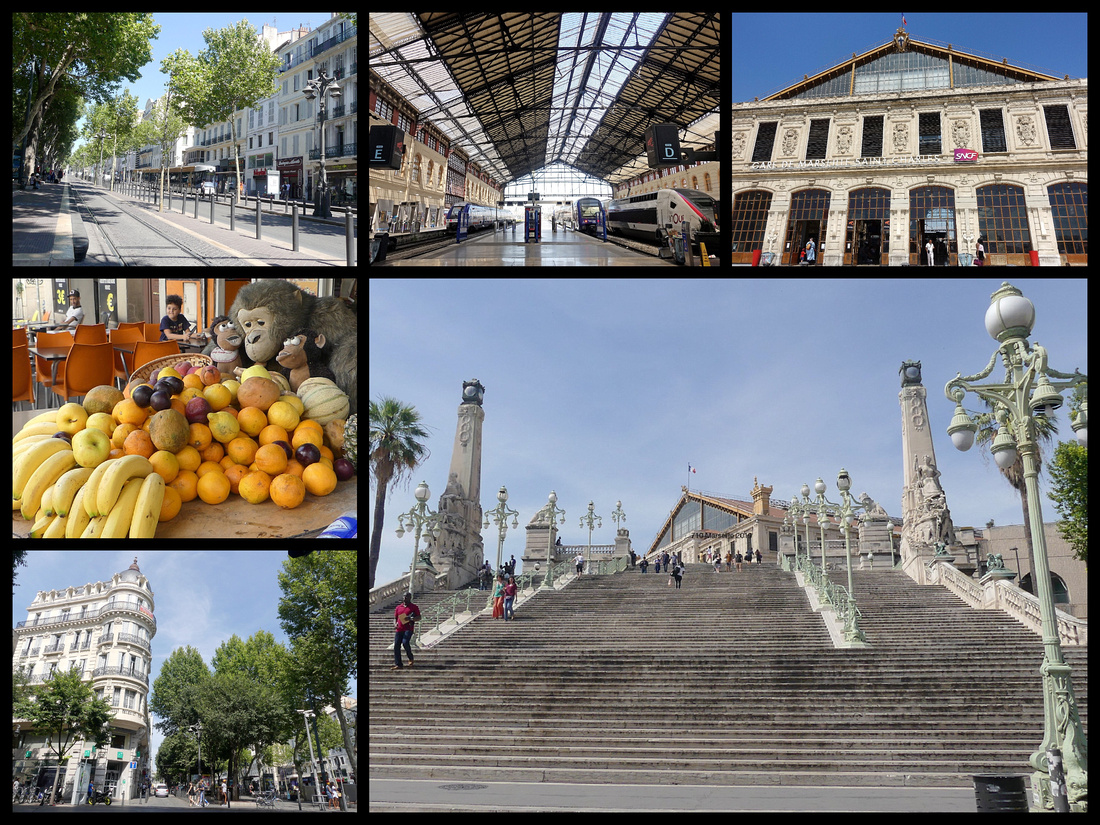

Vieux Port – The head of the port is Quai des Belges where fishing boats still unload their catch for sale every morning. There is also a new modern ‘feature’ – a huge mirror canopy suspended high above the pavement– “Le Ombriere” provides shade and adds visual interest. In the evening this quai is full of street performers and people selling stuff on blankets laid out on the pavement – hats, electronics, etc. as well as hair braiding, henna tattooing, and people selling mint tea.
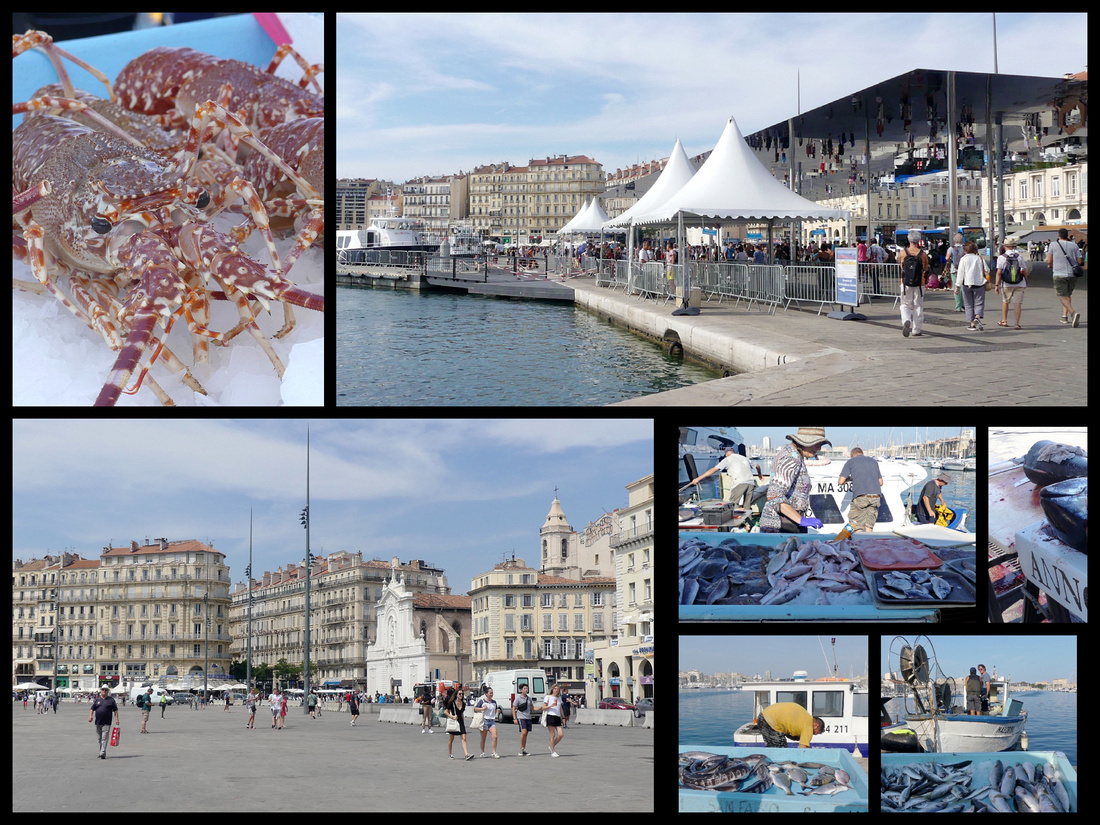

The north side of the port, below Le Panier, Quai du Port, has a large pedestrianized promenade, lined with craft tents of people selling local produce and crafts (soap is a BIG thing in Marseille). The first few buildings are very Parisian (La Samaritine) looking, the rest are 20th century, except the Hotel de Ville, 1673, Genoan Baroque with a huge bust of King Louis XIV and colorful flags. Just behind that is a large square (little kids playing soccer) with several other old buildings: La Maison Diamantee -1570 with carved faceted stones on the façade, Pavillon Daviel, 18th Century former courthouse in Provencal style, and Hotel Dieu – originally a hospital, rebuilt in the 18th Century and now a luxury hotel. And just up the hill from these is the Accoules Church, the second oldest in Marseille, the main part was demolished during the revolution but the bell tower remains. Le Panier district begins here.
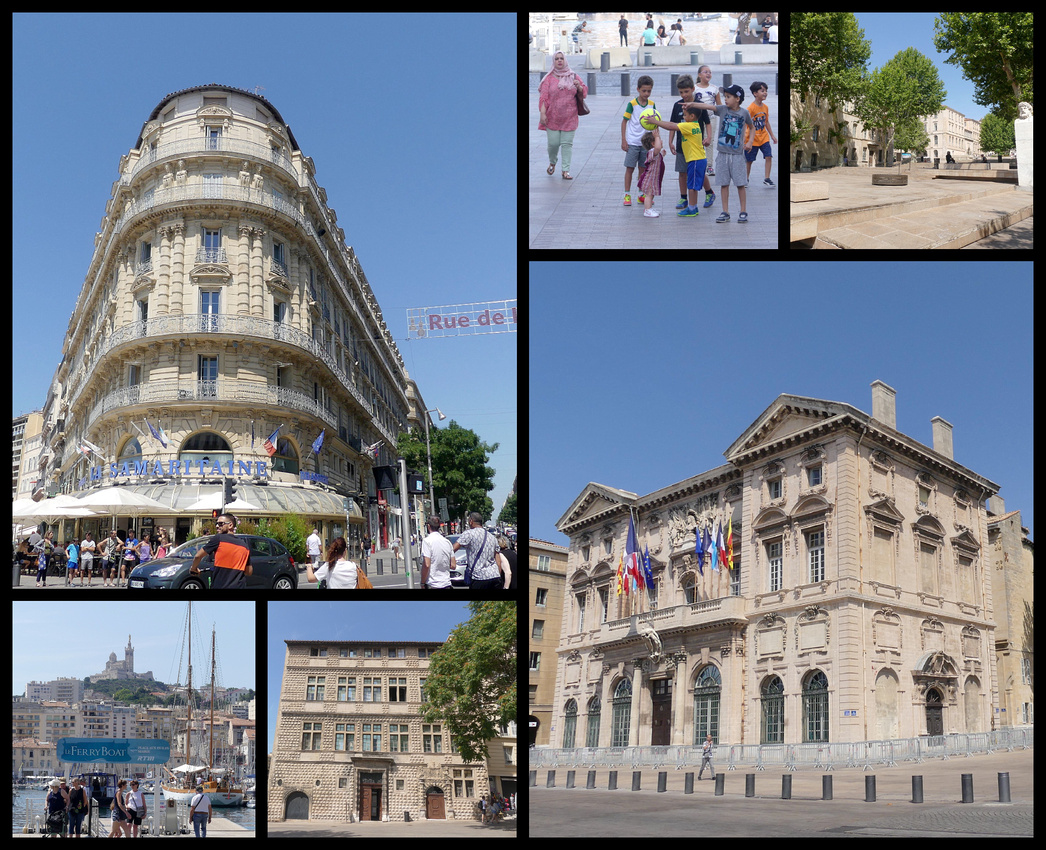

The opposite side, Quai de Rive Neuve has more car lanes, less sidewalk but both sides are lined with restaurants, bars, cafes. The buildings around the harbor are for the most part not terribly interesting. I did find Bar de la Marine, (#15 Quai de Rive Neuve), a 1930s sailor's haunt with an old zinc bar and a mezzanine that was the scene of the salty barkeeper’s saga in the 1932 film Fany and of Jamie’s proposal in 'Love Actually'. There are a couple of larger squares just inland from Quai de Rive Neuve, Place auix Huiles and Place Thiers. 'Le ferry boat' crosses the harbor midway, from in front of the Hotel de Ville, takes 10 minutes and costs 50 cents, and has been a feature of Le Vieux Port for ages. And it does cut down on a good bit of walking if needing to get from one side to the other.
Le Musee Du Savon - the museum of soap. Savon de Marseille is a traditional hard soap made from vegetable oils that has been produced around Marseille for about 600 years. The first documented soap maker was recorded there in 1370. By 1688, Louis XIV introduced regulations limiting the use of the name savon de Marseille to olive oil based soaps. By the 1920s there were 132 soap companies but today there are just 5. Traditionally, the soap is made by mixing sea water from the Mediterranean, olive oil, and the alkaline ash from sea plants in a large cauldron, then heated for several days, stirring constantly. It is then poured into a mold, cut into bars and stamped. The whole process can take up to a month. The museum is privately owned by a guy who has had soap makers in his family for generations. He charges €2 but gives you a ticket you then take next door for a bar of soap worth €1.75 so the museum is effectively free. Small but well done. Soap seems to be the primary souvenir sold all over the city.
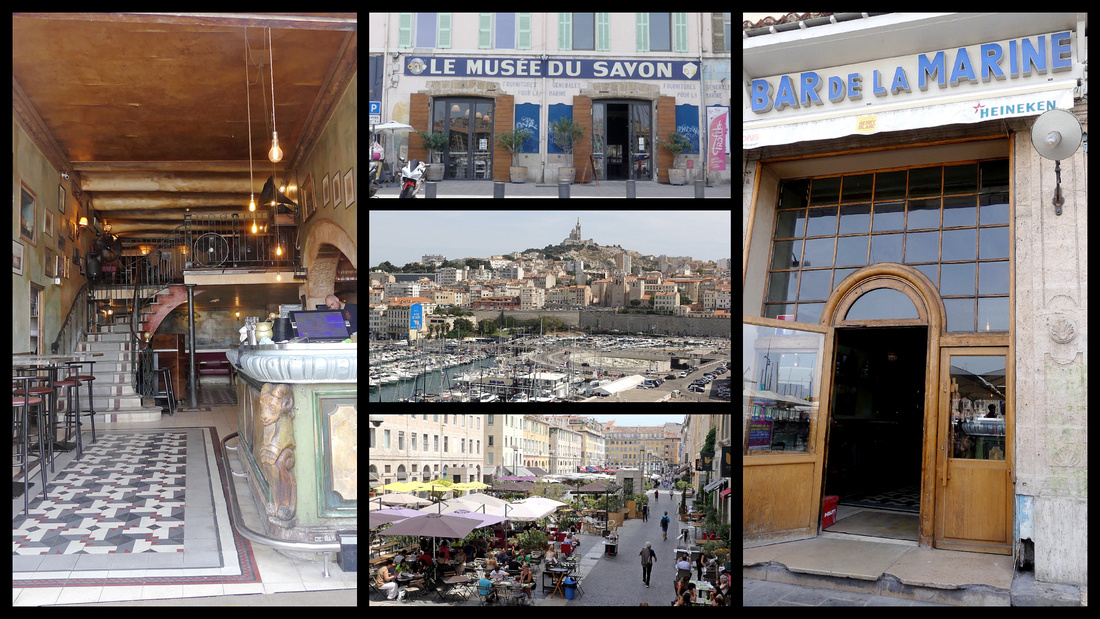

Fort St Jean was built in 1660 by Louis 14th and is beautifully restored. It houses the Museum of European and Mediterranean Cultures, for which you need a ticket, but you can explore the whole fort, including climbing the keep and ramparts and courtyard for free. More fabulous views. The site of the fort has been occupied since Antiquity and in the 13th Century the order of the Knights Hospitallers of St John (future Knights of Malta) built the original fort.
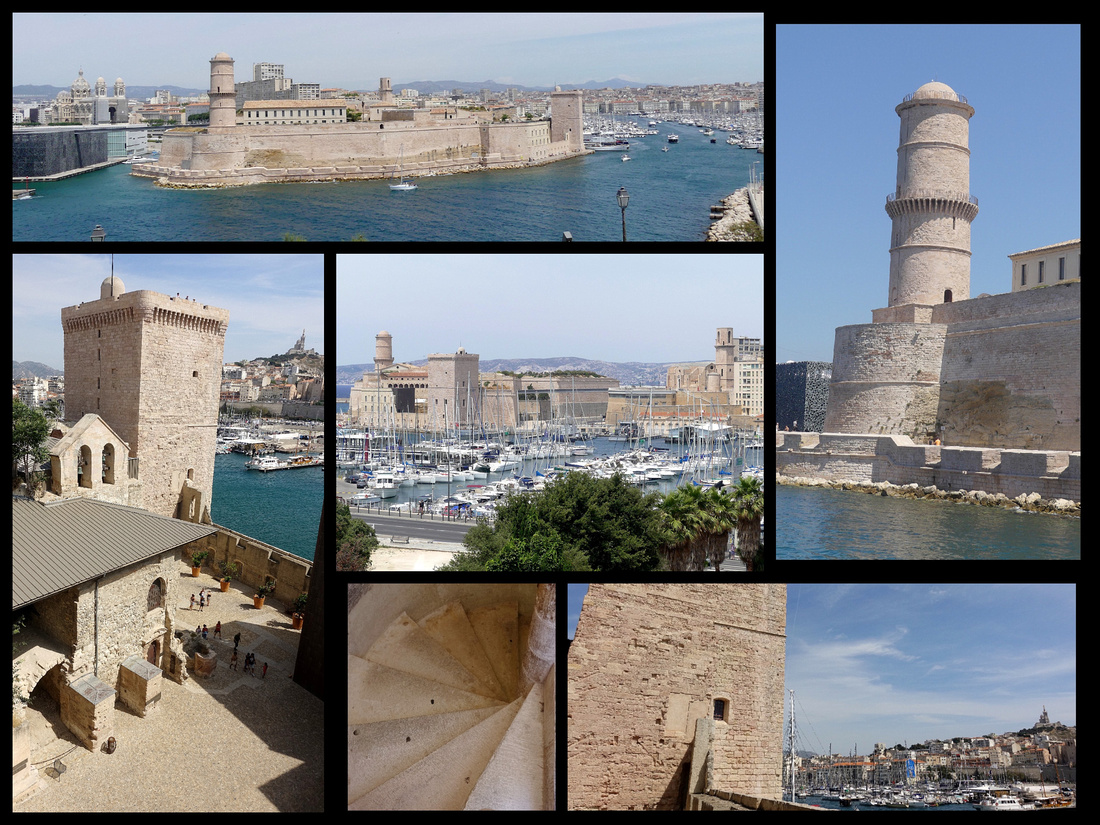

Le Panier – when the Greeks landed in Marseille 2600 years ago this is where they landed. No signs of Greeks today (there is a mural depicting their arrival, near the cathedral) but it is the oldest neighborhood with narrow, steep (and more often than not, stepped) streets lined with tall houses in various states of disrepair giving the area that ‘colorful shabby’ ambiance. Lots and lots of street art – murals everywhere. Lots of regular graffiti as well but there is so much of it, and most of it so well done that it really ads rather than detracts. Flowers in flower boxes and pots, laundry flapping in the breeze. Several small tree lined squares – Place de Lenche, Place des Treize Cantons, Place des Moulins, Place de Pistoles. A few cafes, some art galleries, a few shops – mostly quirky, nothing very upscale but all very interesting. Le Panier means ‘the basket’. This area was a melting pot where immigrants from Naples, Corsica, Catalonia and rest of the Mediterranean coast mingle with the French West Indies, Africa and Vietnam. The Panier became a working-class district when the Marseille middle-class decided to move out in the 17th century to relocate in the new districts, the people who remained largely made their living from the sea – fishermen and sailors.
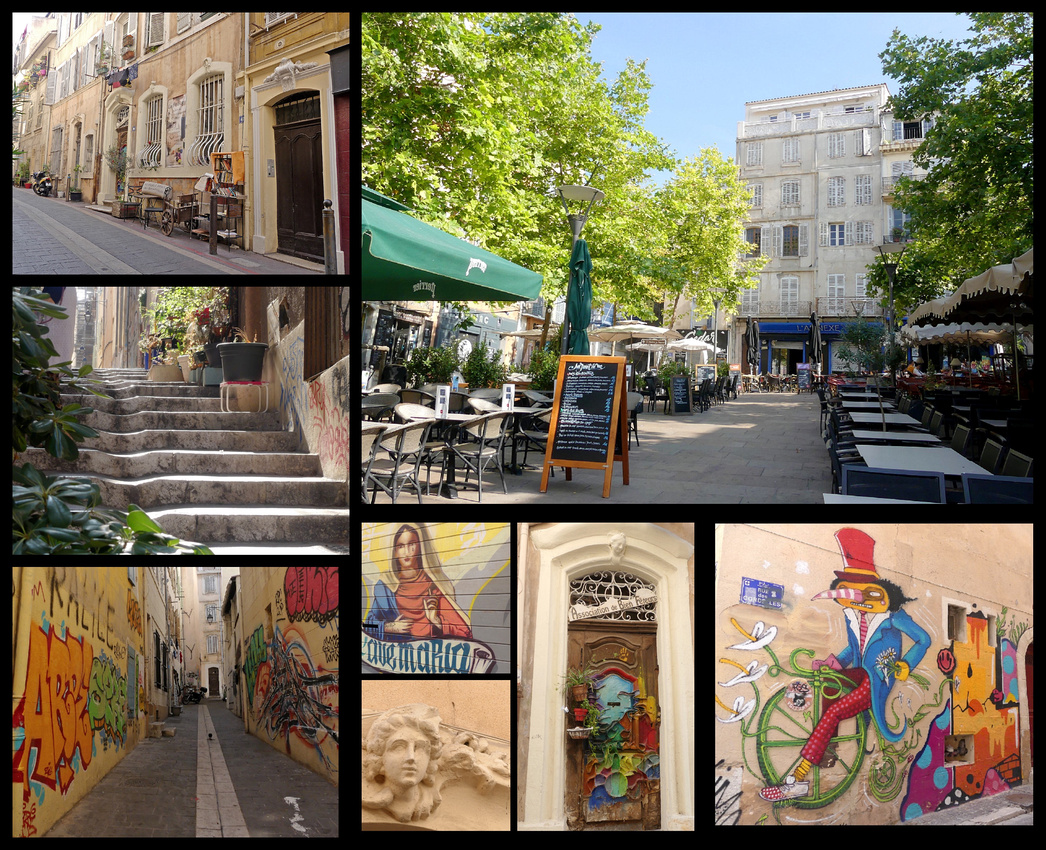

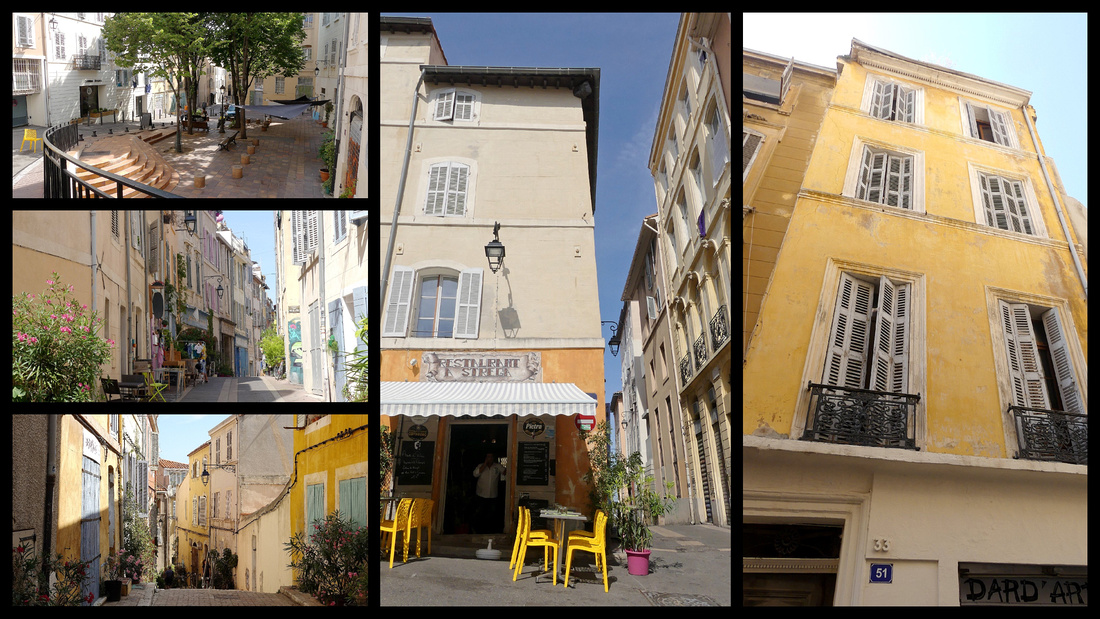

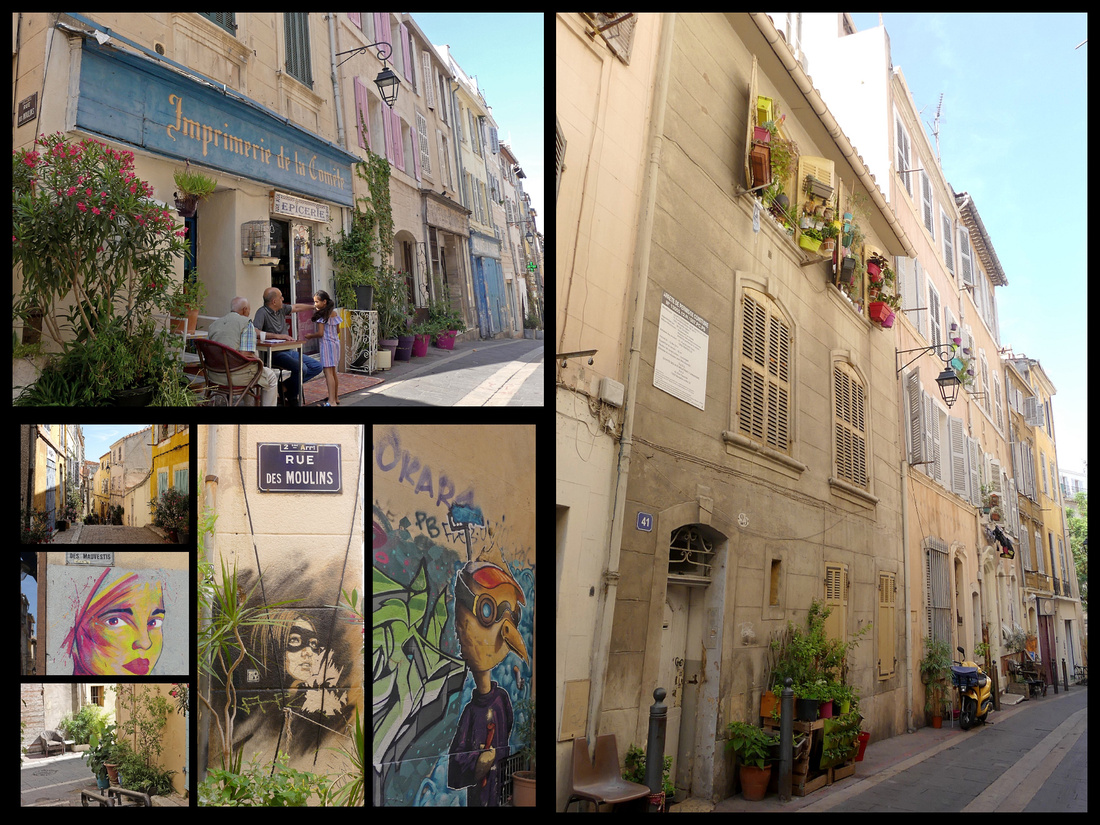

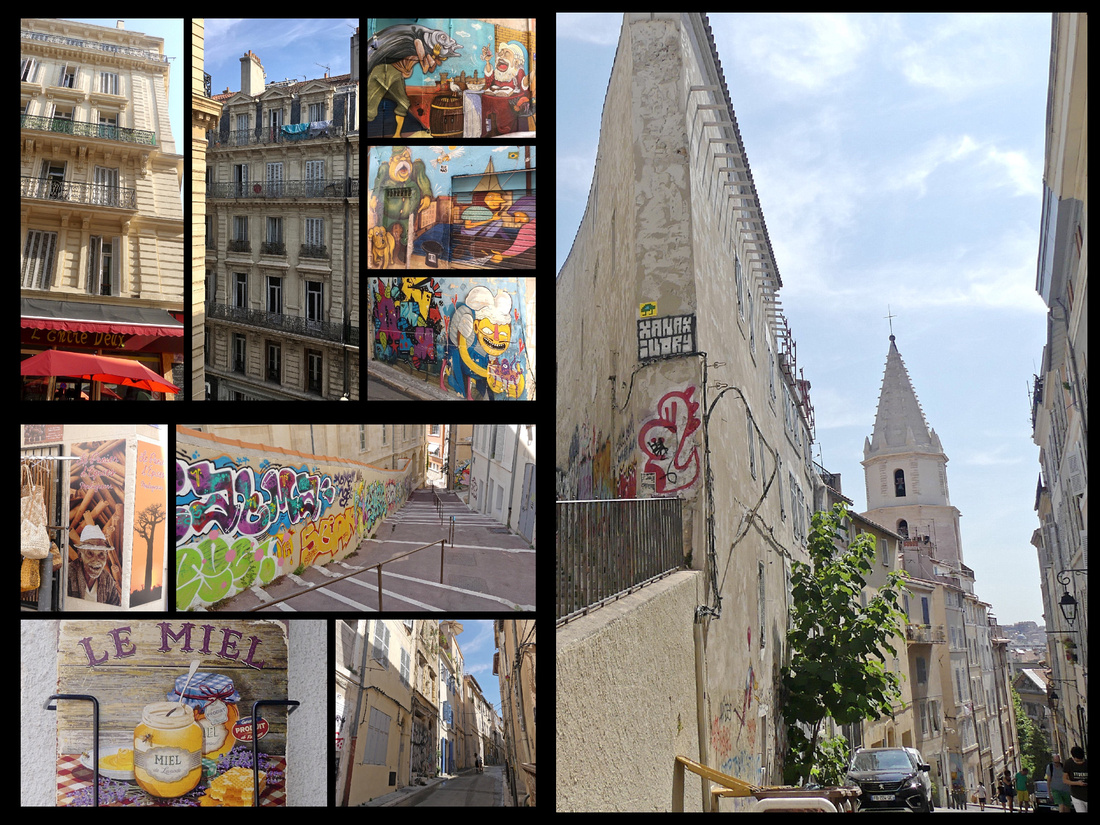

Above top left: View from my hotel, street art in the lane near it; Right: Accoules Church tower from La Panier
One of the major ‘sites’ in the area is the Cathedrale de la Major - Roman Byzantine finished in the 19th C. Largest built in France since the Middle Ages. Right next to it is the 12th century Romanesque Church it replaced. Opposite the two cathedrals, on esplanade de la Touret, a mural illustrates the ancient Greeks arriving at Marseille, and at the end of the esplanade, opposite Fort St Jean is the small Romanesque Church of St Laurent, built on the site of a Greek Temple of Apollo.
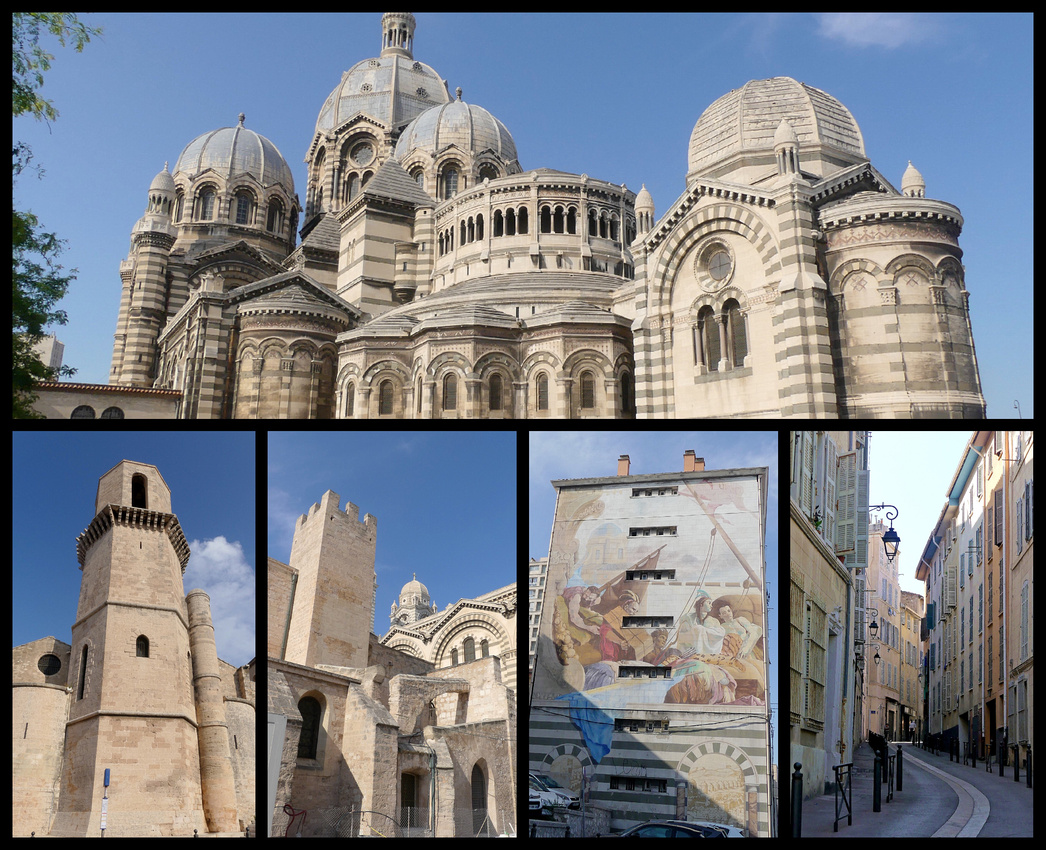

Above top: Cathedrale de la Major Lower left: St Laurent; 12th Century church in front of Cathedrale de la Major; Mural of Greeks arriving in Marseille
The other major site is the Vieille Charité, Marseille's architectural gem. Built between 1671 and 1749 to care for the city's paupers and sick, this former hospice is a masterpiece of Italian Baroque. It consists of a rectangle of arcades on three stories nestled around a courtyard with a Baroque chapel with unique oval shaped dome) in the center. The complex houses several museums for which you need a ticket, but you can explore the building (all three levels) and courtyard for free.
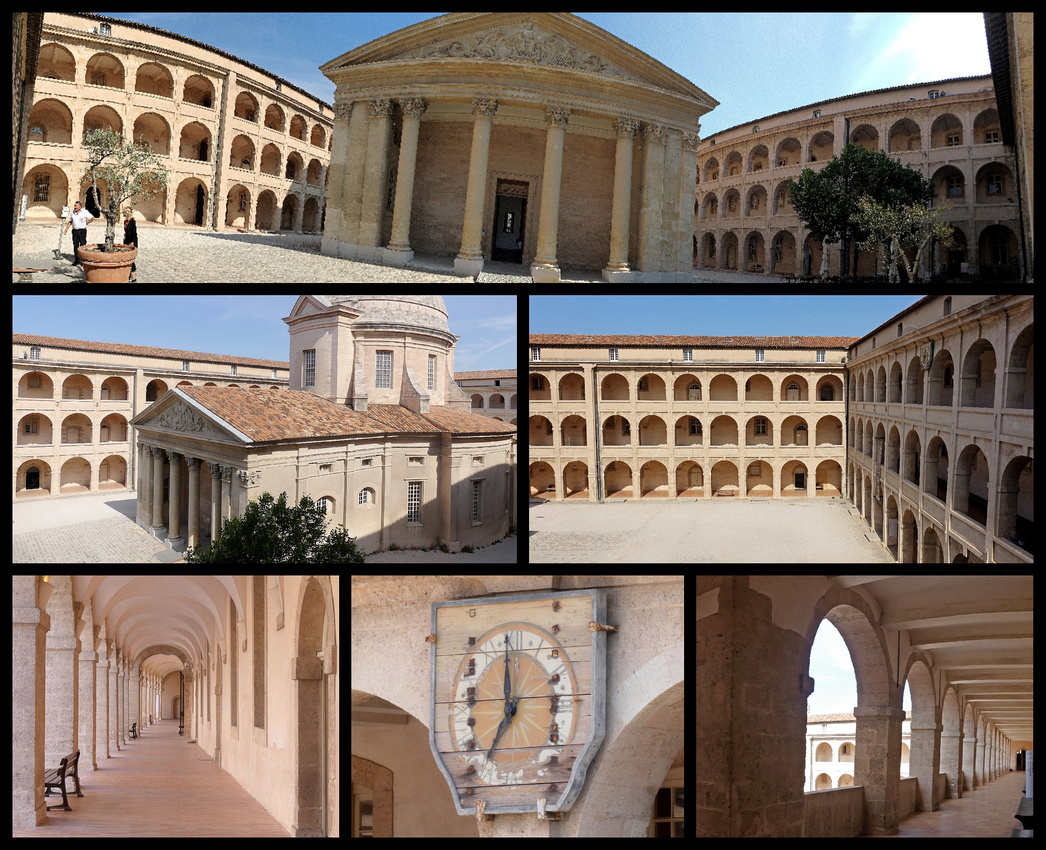

The major ‘site’ on north side of the harbor is Notre Dame de la Garde, high on the hill which can be seen from virtually everywhere in the city (in fact it was the first thing I saw coming out of the train station). Neo-Byzantine finished in the mid 1800s. Notre Dame de la Gard was built on the foundations of an ancient fort at the highest natural point in Marseille, a 149 meter (489 ft) limestone outcropping. Originally an enlargement of a medieval chapel, it was transformed into a new structure in neo-Byzantine style in 1852. This is where sailors went to thank God for surviving shipwrecks and there are model boats (and one airplane) suspended from the ceiling and paintings of ships and the sea on the walls. Beautiful mosaics and marble work. The interior is nowhere near as large as it appears (you can see the basilica from virtually everywhere in Marseille). The 11 meter tall gold Madonna and child topping the huge bellower makes it seem larger than it is. The views are of course, stunning and include all of the Vieux Port, the Chateau d’If in the harbor and the beginning of the calanques.


Abbaye St-Victor, a genuinely superb ancient church. The above ground portion of the abbey dates from the 11th to 14th centuries and looks like a fortress, but the main interest is in the spooky 5th century crypt. Marseille's oldest church (1600 hundred years, one of the oldest in France), was originally part of a monastery founded in the 5th Century, the church was enlarged and fortified – a vital requirement given its position outside the city walls – over a period of two hundred years from the middle of the 10th Century. It looks like a more like a fortress than a church. The crypt is a fascinating, crumbling warren containing several chapels and passages, and a series of antique, pagan and Christian sarcophagi. Much larger than most crypts, it’s essentially the same size as the church above. Free. Crypt €2.
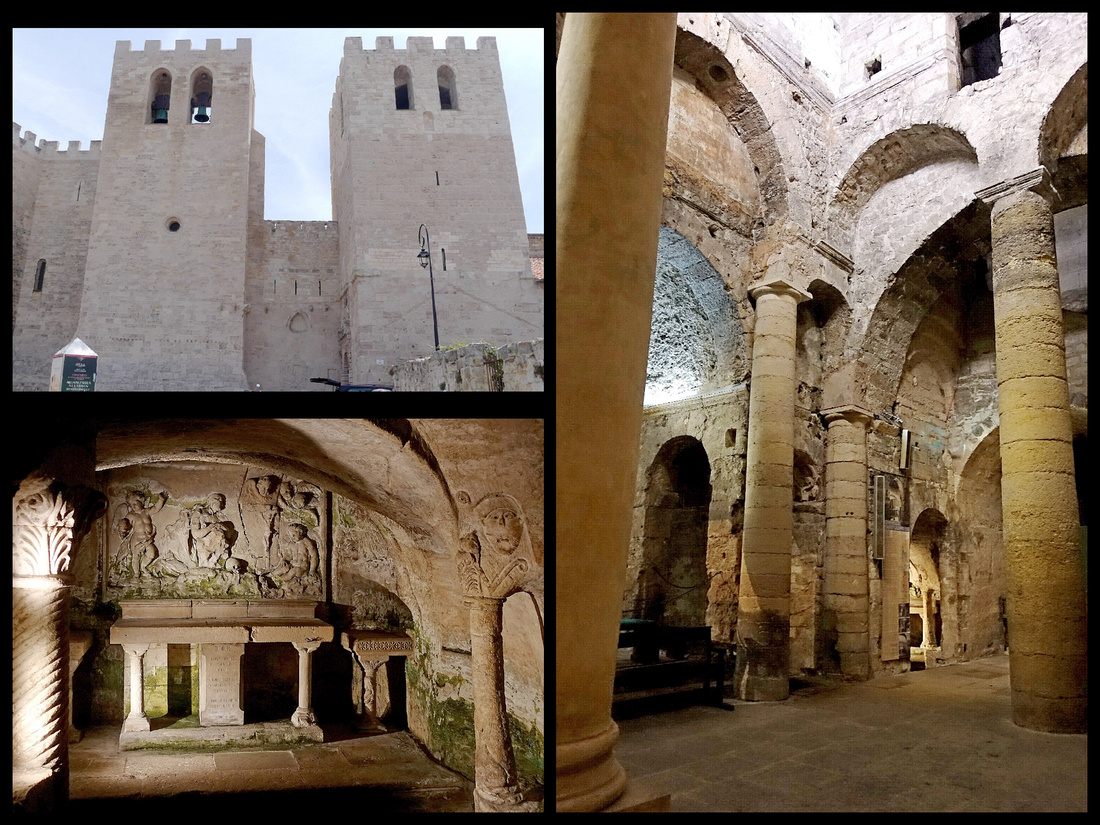

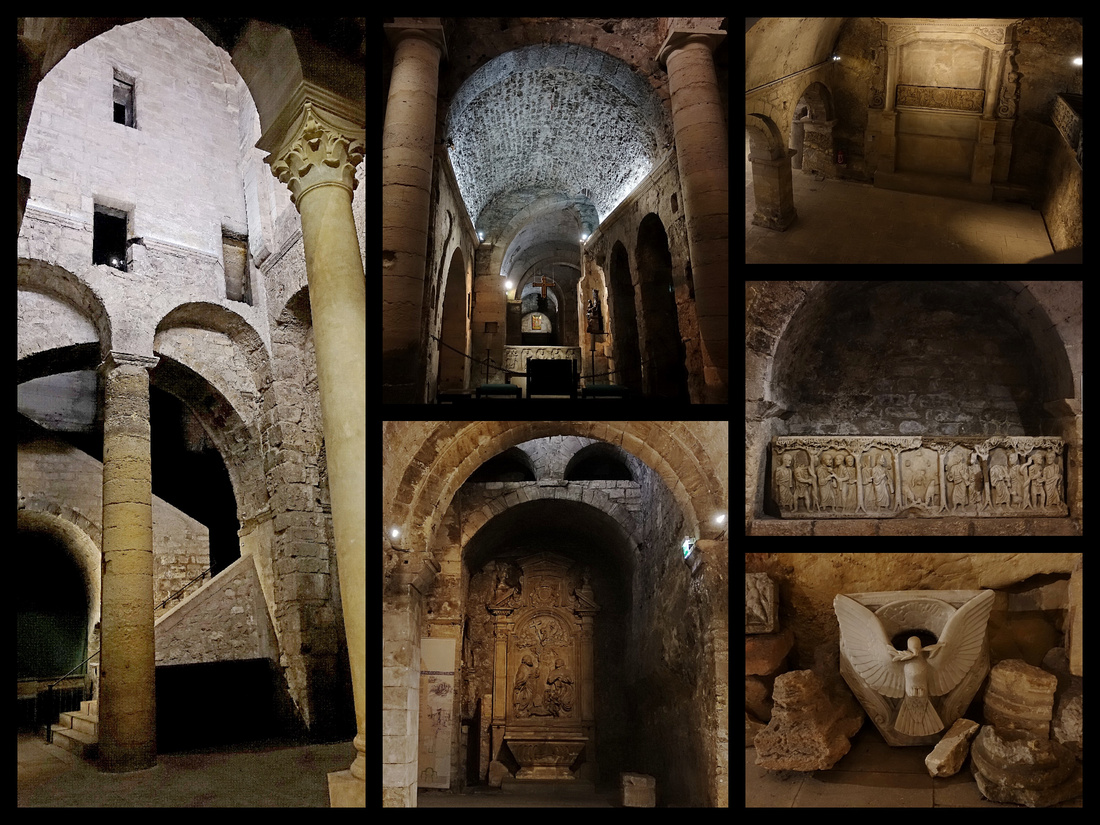

Both sides of the harbor are guarded by massive fortresses. The north side has Fort St Nicholas, massive but largely in ruin. It was built in 1660 on the orders of Louis XIV. The site itself is even older and once held a tower used to operate the chain that closed the entrance to the port. It was taken as a trophy by an army from Aragon in 1423 and is now in Valencia cathedral in Spain. When Napoleon built the Palais du Pharo the fort was cut in two to allow for a road and has been in ruin since.
Just beyond Fort St Nicholas is the Palais and Jardin du Pharo. Château du Pharo, built in the 1860s by Napoleon III for his empress (now a convention center) is surrounded by a nice park with drop-dead gorgeous of the whole port and the much more impressive Fort St Jean across the harbor.
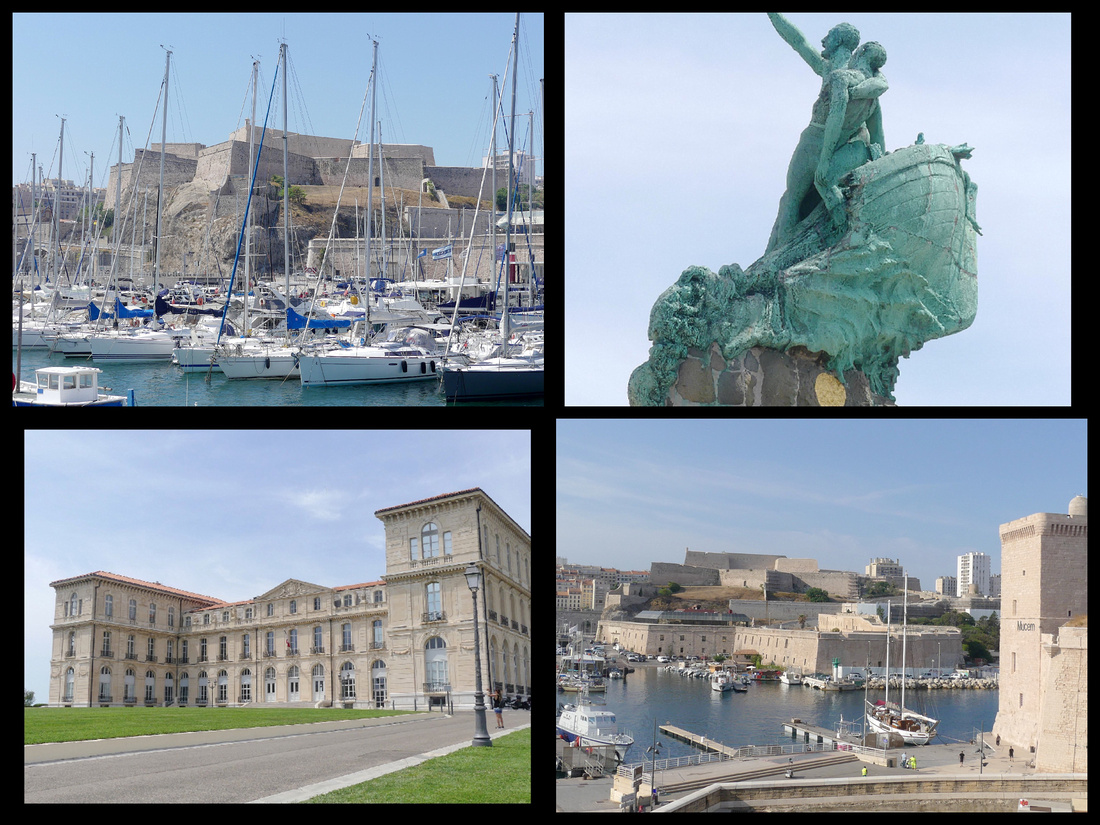

Vallon des Auffes, along the Corniche President John F Kennedy, is the nearest Marseille gets to being picturesque, with small fishing boats beached on the rocks and narrow stairways leading nowhere. There are steps from the road down under the bridge to the harbor. The vallon is a three arch bridge over an inlet from the sea to a tiny harbor.
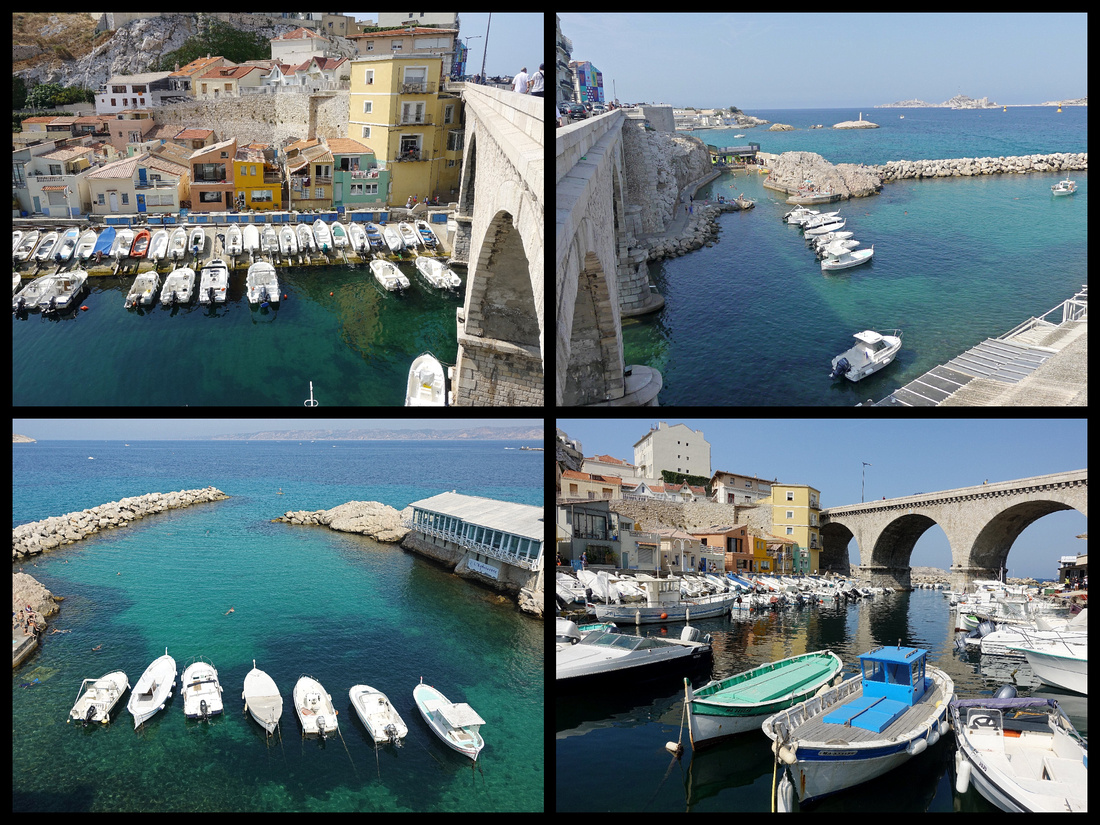

I had read that the Corniche President John F. Kennedy was 'dominated' by elegant late 19th century Belle Epoque villas. Not quite, there are a few but mostly it's 20th century rather homely buildings, but the view of the water is fabulous, multi shades of blue and green, white rock. There are a couple of small ‘beach’ areas (the one actual beach is further down the road), some boats, views out to Chateau d’If. Worth taking the bus to the area and walking along the cornice for a ways but would be a boring walk to try to walk there from the city center or to walk further than the Vallon des Auffes, as it goes inland for quite a ways. Bus 83 is frequent and takes 10 minutes from Vieux Port.
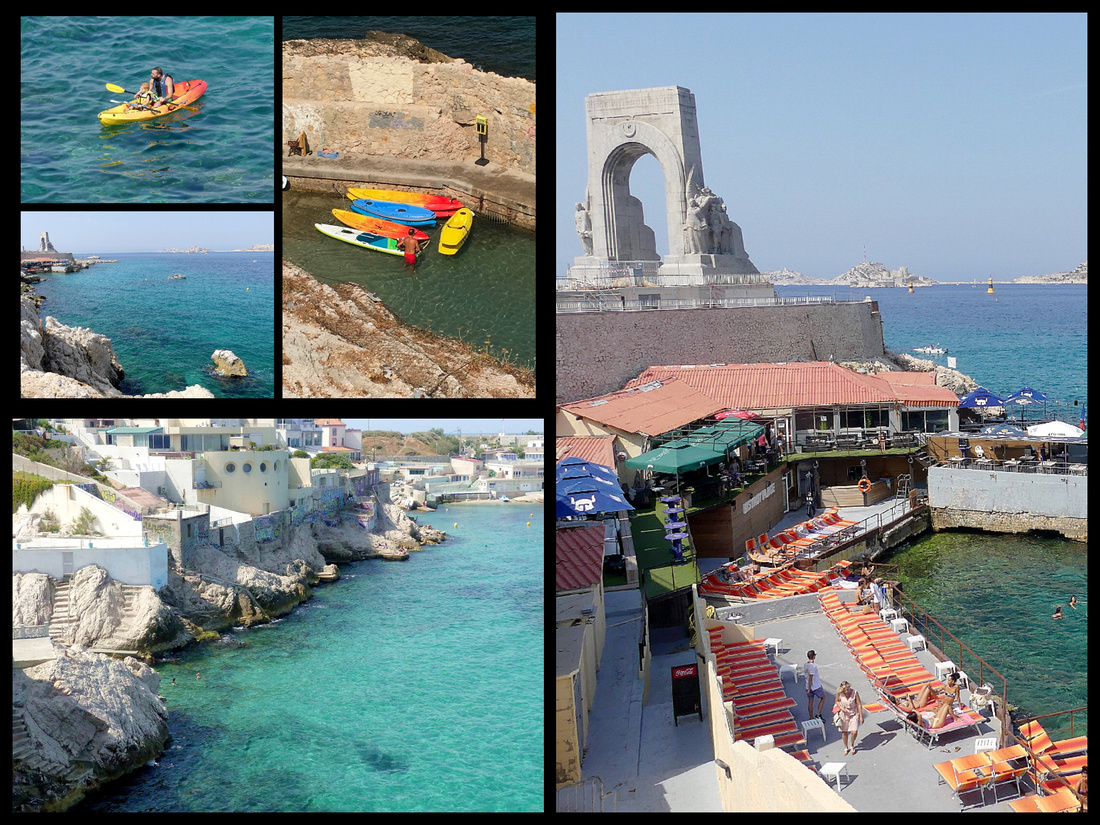

Calanques National Park Boat trip. (€30, 3¼ hours), departs at the top corner of the Vieux Port (2 minute walk from the hotel). There are two options, the ‘grand’, which I did, and the ‘petite’ (24€, 2¼ hr). About 3 of each per day unless the seas are too rough and then they cancel. Boats holds between 150 and 200 with upper deck outside and lower deck in and outside seating. Goes right by, but doesn’t stop at, Chateau d’If, famous as the site of the prison in the Count of Monte Cristo. The National Park consists of the coast between Marseille and Cassis and much of it lies within Marseille city limits which makes it the only European National Park within an urban area (though after the first ten minutes of the boat ride you would never know).
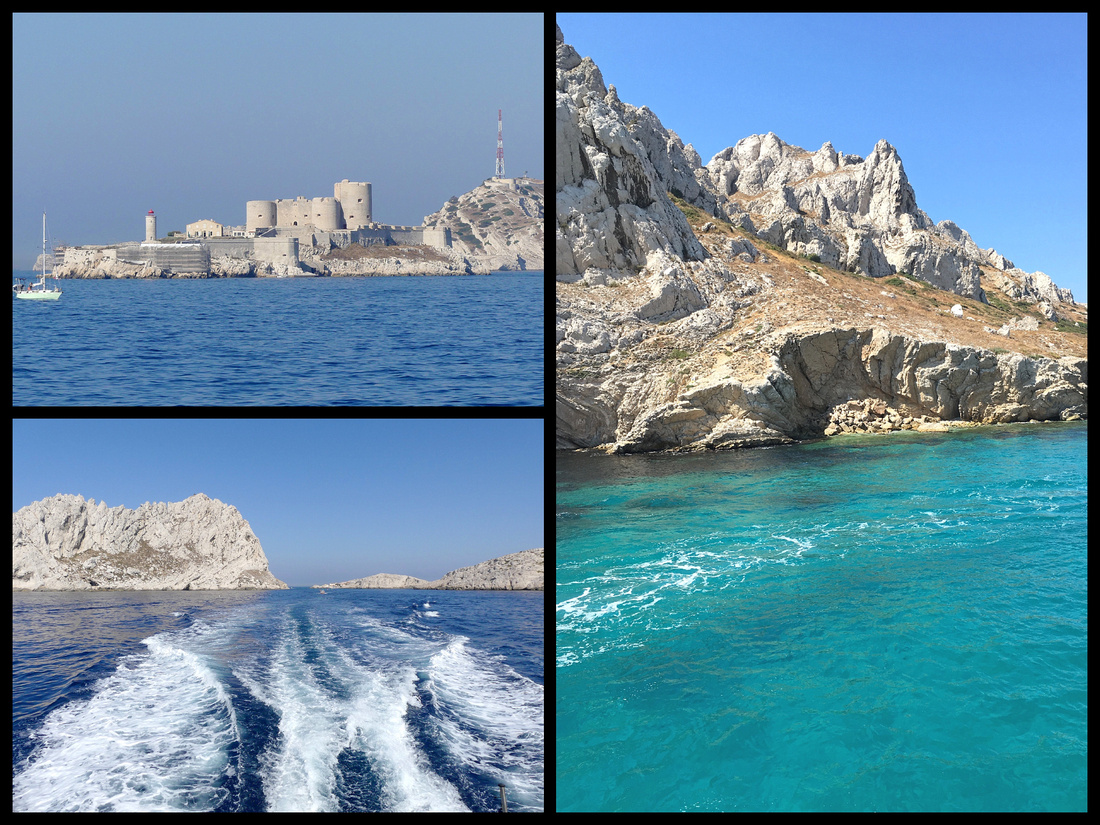

The word calanque comes from the Provençal cala, meaning "steep slopes." Fjord like coastal valleys create steep inlets. They're similar to fiords, created by glaciers, but these gorges have been created by the raging sea. Cliff faces overhang the sea which attracts rock climbers and deep-sea divers. The coves cut deep into limestone rock walls, forming pools of seawater that are as calm as lakes. Because the light reflects off the white limestone, the water appears a stunning turquoise color. It has the highest maritime cliffs in Europe.
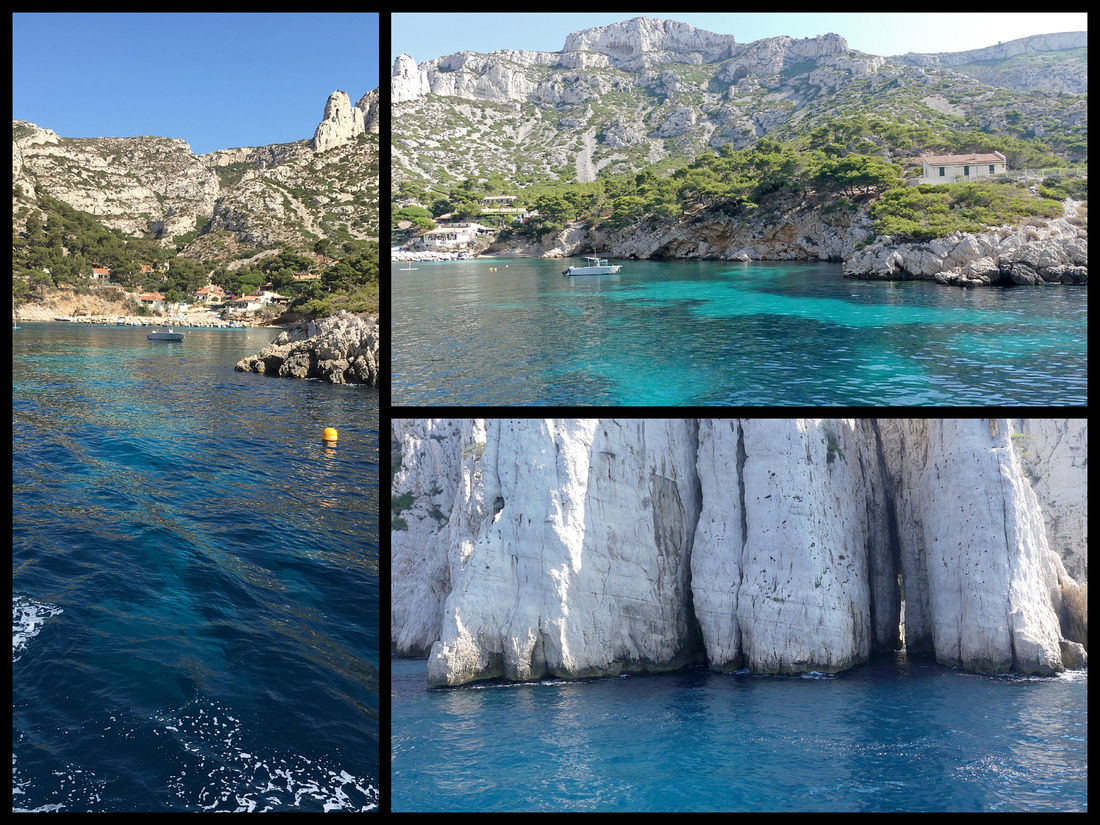



CASSIS
One day I took a bus to Cassis, just up the coast from Marseille. I had see it from the boat ride and read that it was
“A picture perfect fishing village guarded by ruins of a medieval castle (1381) (Chateau de Cassis, now a luxury hotel). The prettiest coastal town in Provence. Pastel cubist houses frame the port, unadulterated charm.” That pretty much does describe it. Certainly a tourist town these days with plenty of boats, some of them might actually be used for fishing, the majority are pleasure craft but some are really cute. And tons of excursion boats into the calanques. Besides the delightful harbor lined with restaurants and shops, there is a large beach and a few picturesque back streets.


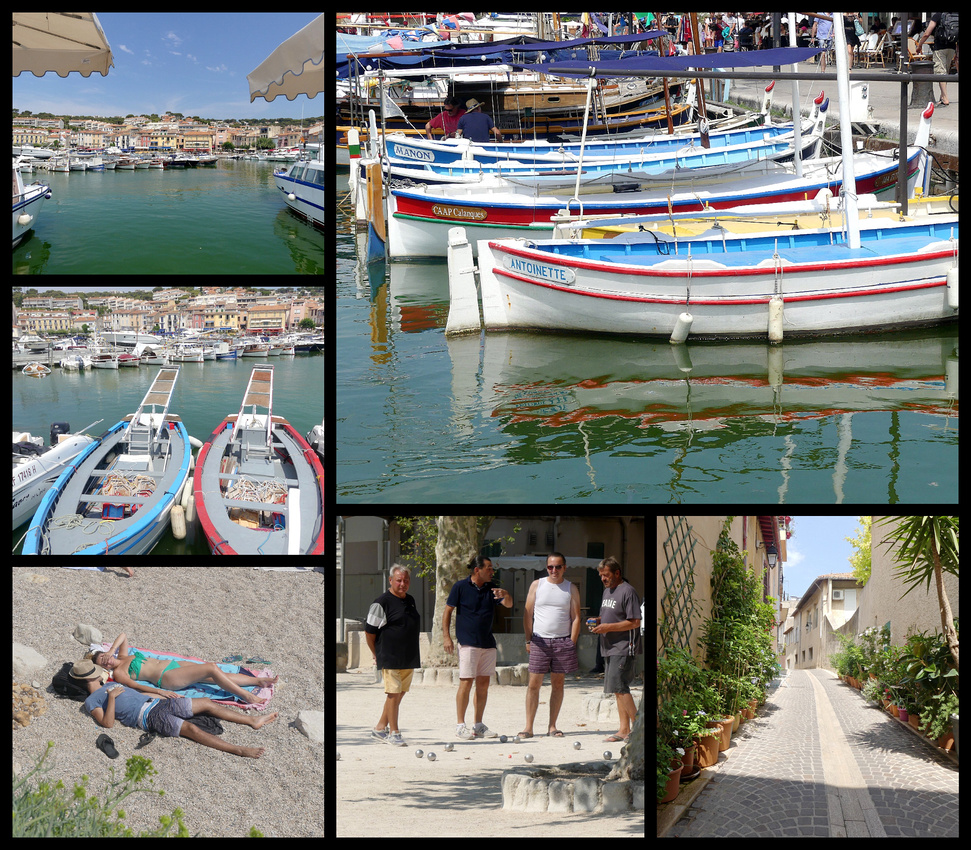

Since Cassis is the end point of the calanques boat tour from Marseille that I took the other day,(and with the help of the map) I knew Calanque de Port-Miou – a long narrow calanque completely lined with sailboats – was just around the point from Cassis town harbor. With a handy map from the TI I hiked up there, took less than an hour and does have gorgeous views if you walk out onto the rocks far enough (tad scary but probably pretty safe). You can hike to several other clanque from Cassis but the map says they are 3 or more hours.
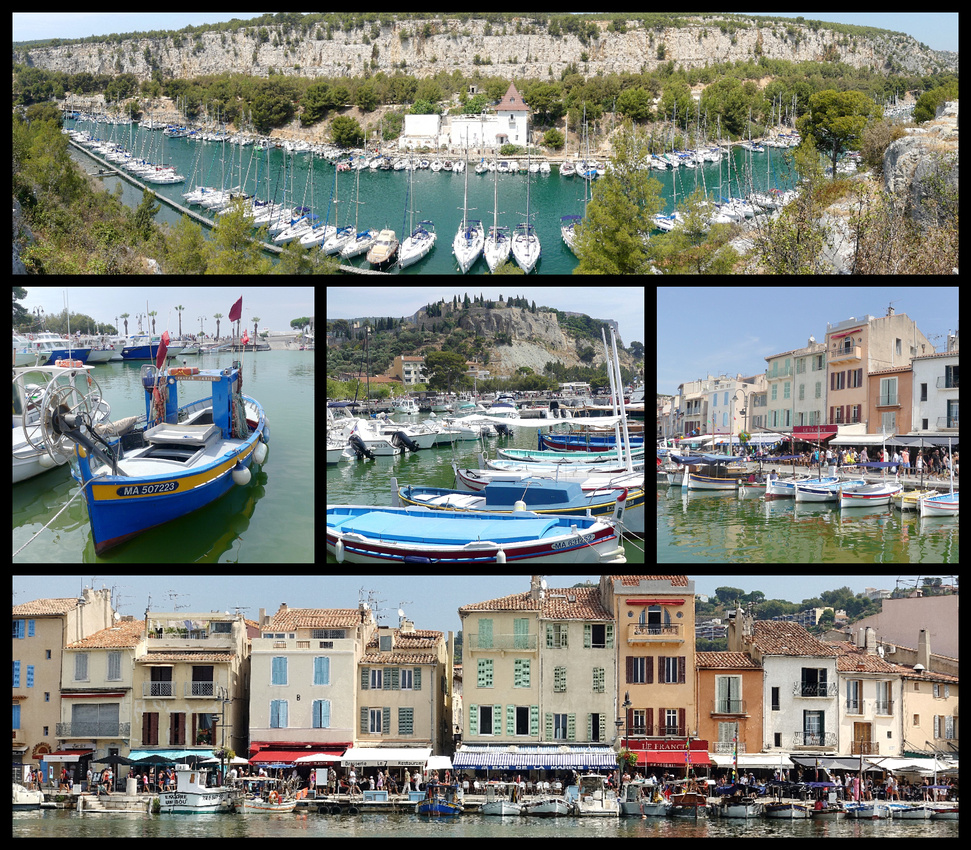

Back at the harbor I looked over the restaurant selection (plenty in all price ranges) and decided on crepes at an outdoor restaurant right on the water. Great food and great people watching.
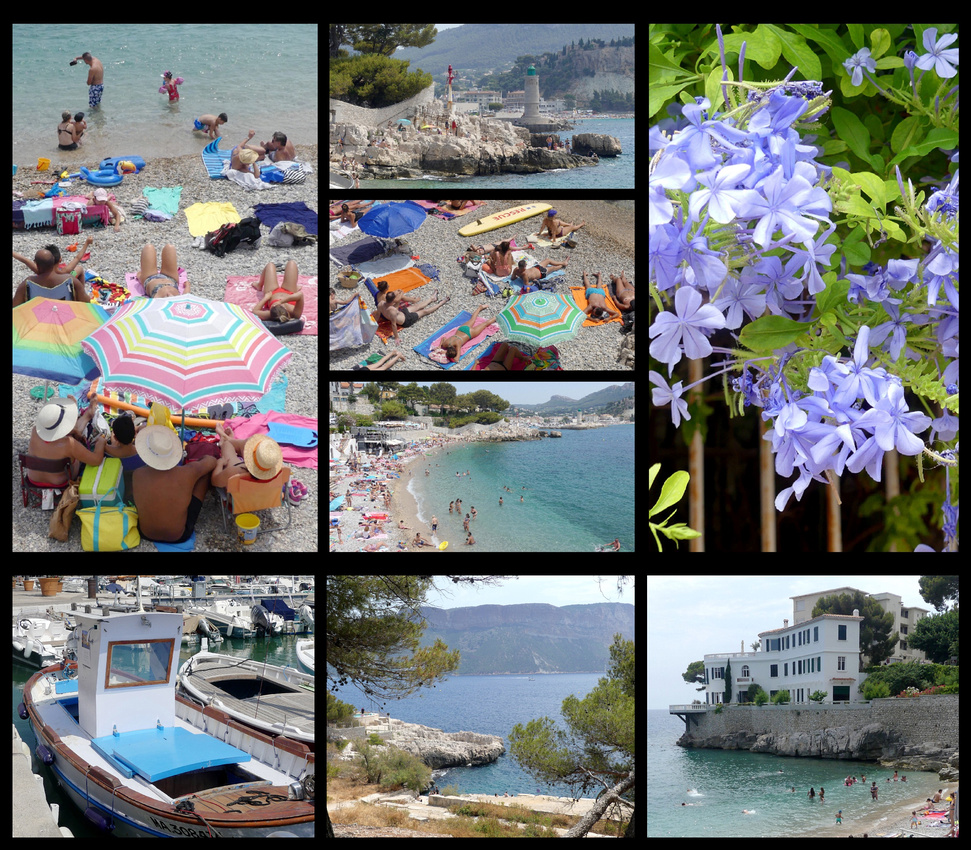

NIMES
Despite being in the Languedoc-Roussillon region (Marseille is in Provence), Nimes, population 148,000, is only a one-hour train ride away. If it weren’t for the Roman monuments (and they ARE outstanding and reason enough to go) Nimes would just be another medium sized city. It’s well kept, there are several parks, lots of pedestrianized shopping streets and a few nice squares. The street leading from the train station to the arena is itself almost a park with lots of trees and benches. There are sycamore trees, cicadas – you know you are in Provence - but the buildings in Nimes are sort of ‘hum’ and it just doesn’t have much character. Good thing it has those Roman monuments. That makes it definitely worth a visit.
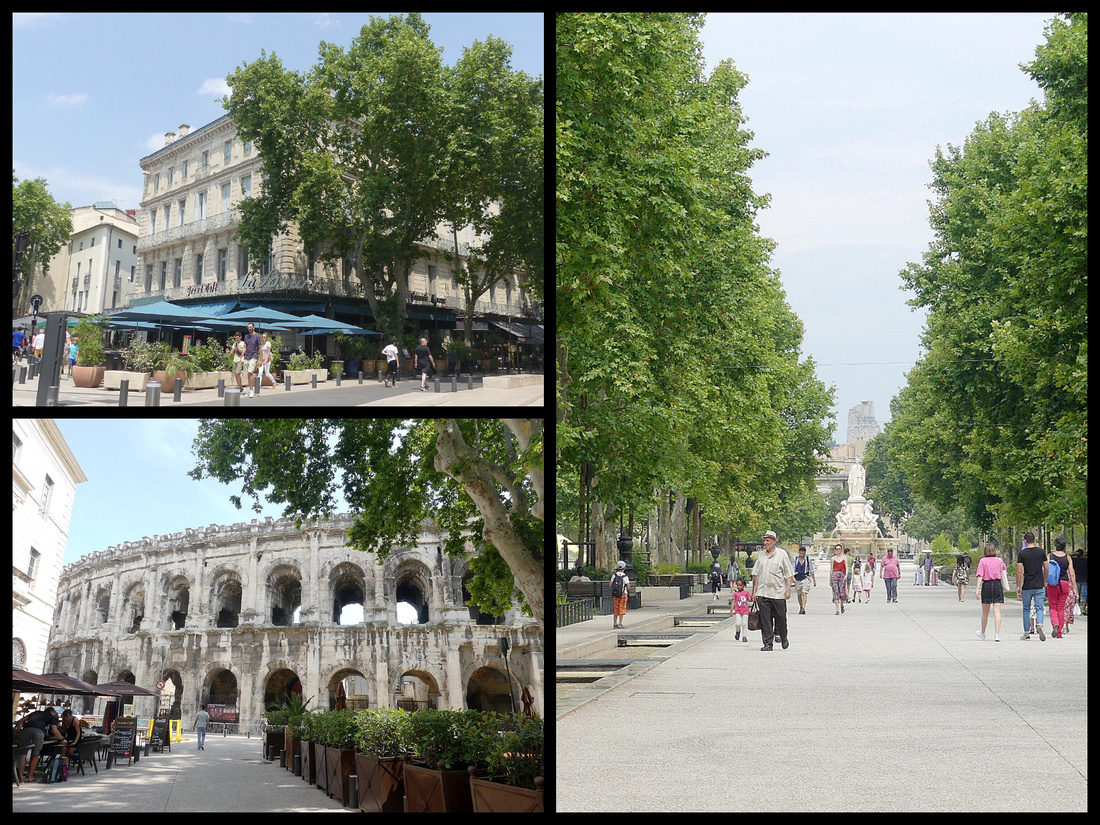

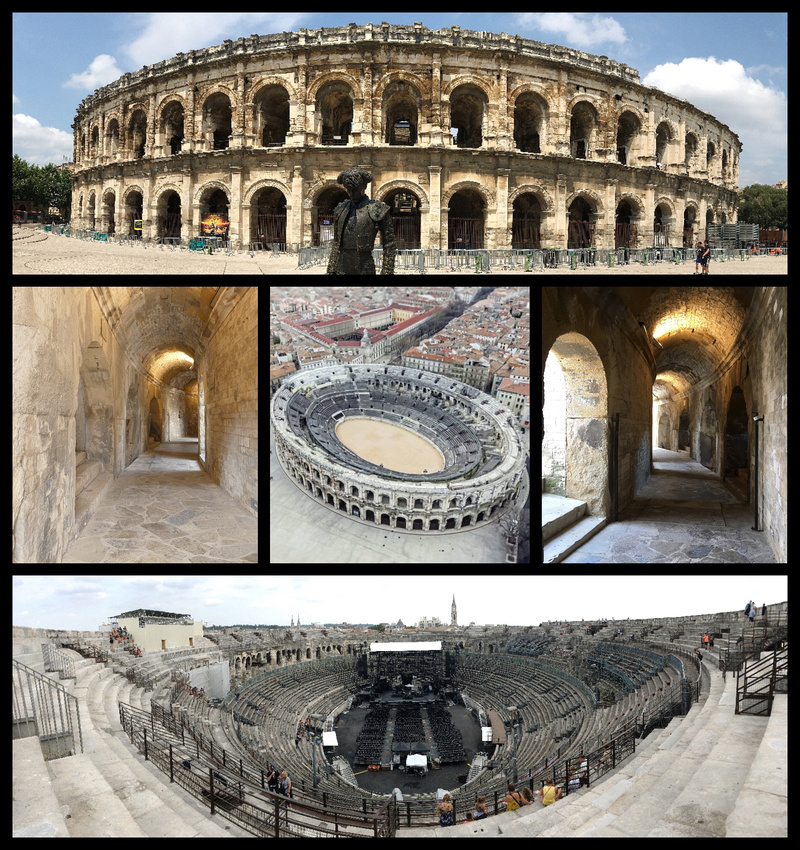

Arènes (Amphitheater) - 1st C AD. Could seat 24,000 spectators, It is 20th in size but supposedly #1 in state of preservation of all the existing Roman amphitheaters. The 60 graceful arches of the exterior are embellished in the lower part with pilasters and in the upper part with decorative Doric half-columns. The Amphitheater was perfectly designed to handle the crowds; there are 124 exits that allowed the entire audience to exit within a few minutes. (In comparison in terms of size: Nimes 133x101, Pula 132x105, Arles 136x 109, Rome 189x156, Verona 152x123). The Amphitheater was transformed into a fortress in the 5th Century and then a knight's castle during the Middle Ages. Now restored to its original purpose – which of course means modern seating and staging that does detract from the picture. Still it is pretty amazing how large and complete it is.
Maison Carree - one of few, fully preserved classical Roman temples remaining in the world. 1st Century BC. Inspired by the temples of Apollo and Mars Ultor in Rome, features harmonious classical proportions. Although there are modern buildings surrounding it, there is enough space left around it that the building can be appreciated. The facade of Corinthian columns is decorated with acanthus and a staircase of 15 steps leading up to the porticoed pronaos (entrance to the temple). It inspired builders of La Madeleine in Paris, and Thomas Jefferson’s Virginia Capitol building. The interior however has not been restored, it houses a theatre showing a video on the history of Nimes, every half hour.
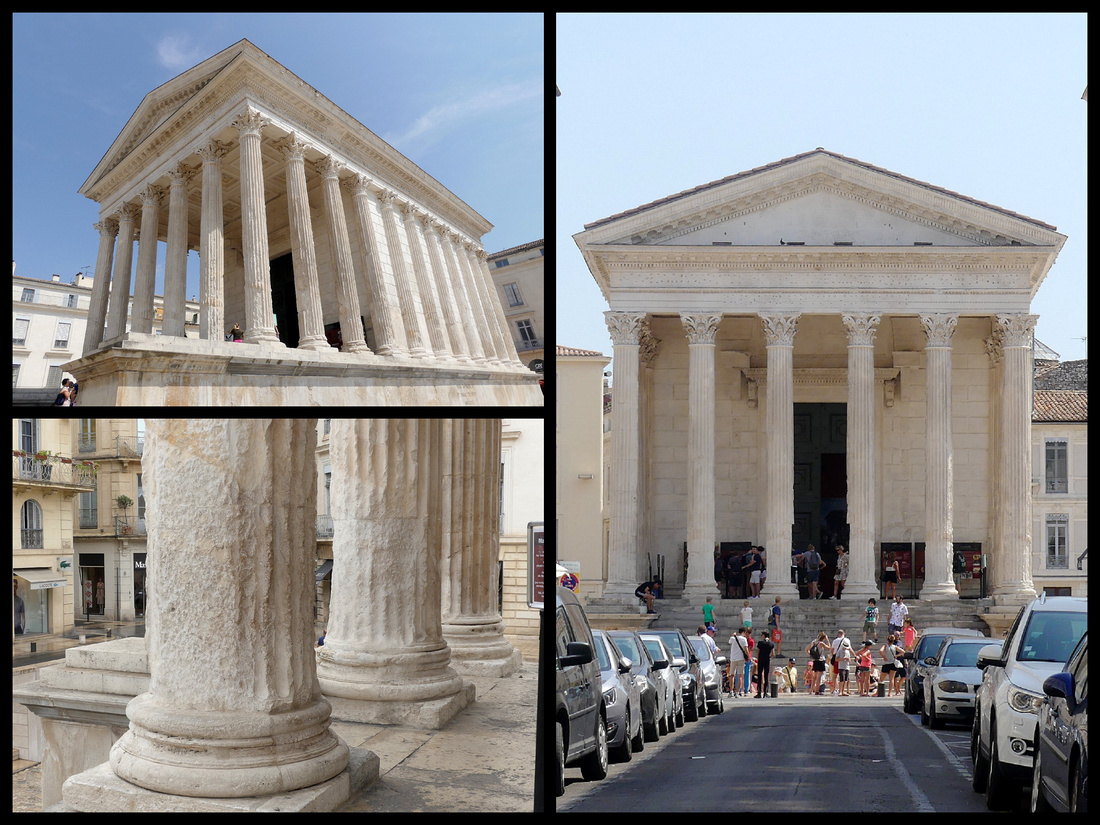

Strolling through town the first square you come to is Place du Marché, which features two figures from the Nîmes coat of arms: a crocodile and a palm tree, symbolizing the Emperor August’s defeat of his arch rival Marc Antony and his lover Cleopatra, Queen of Egypt. The crocodile sits in the middle of a fountain and there is a large palm tree in the center of the square (which is much more a rectangle) has lots of pavement cafes and restaurants. Nearby Place Aux Herbes, is the prettiest square with Notre Dame et Saint Castor Cathedral. There has been a religious building here since the Roman temple of Augustus, and the northwest tower and a few arches on the facade were constructed in the 1100s. The rest of the building has a 19th Century neo-gothic design, If you study the cathedral’s facade you can make out a row of holes above your head to the left of the portal; these were made by medieval market sellers, who would fix their stalls into the wall, as Place Aux Herbes was the old market square. The third square is Place/Tour de l’Horloge, a 500 year old square with a clock tower rebuilt in the 18th Century.
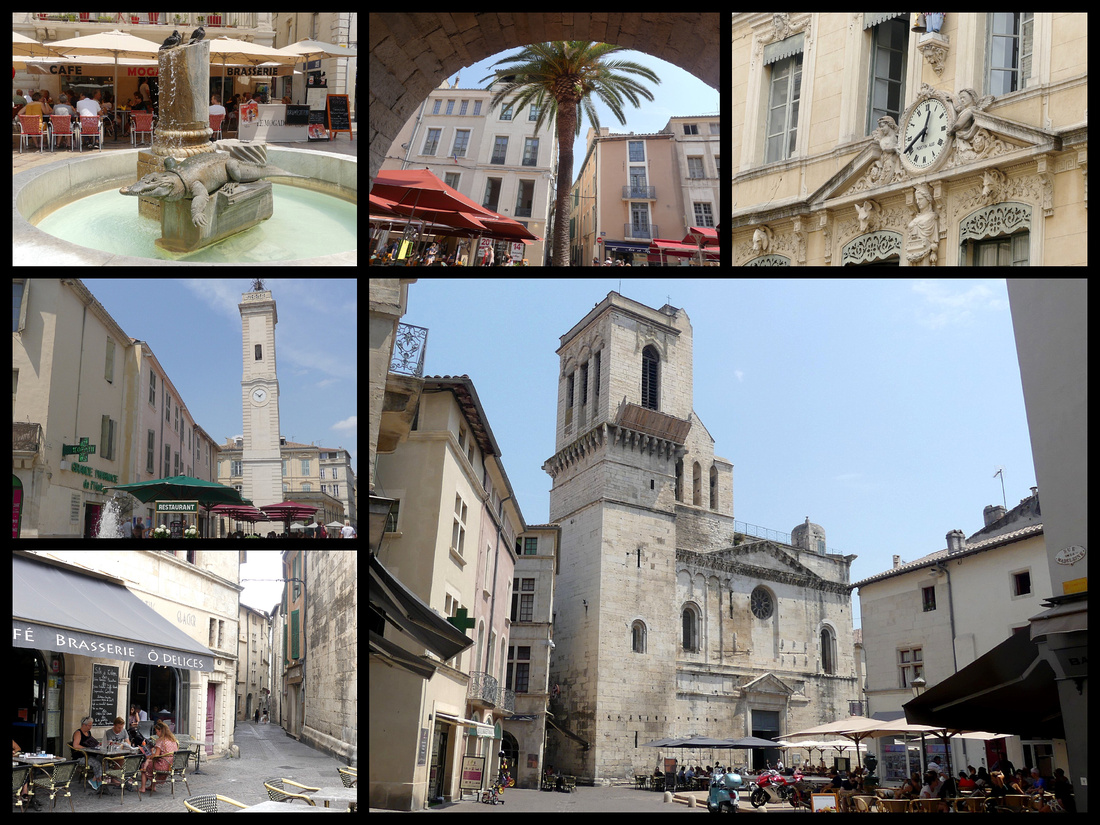

Jardins de la Fontaine – Although the gardens are 18th Century they are built around the water source where ancient Nîmes was founded. There are regal balustrades, broad stairways, statues and marble vases, but also Roman monuments – the Temple of Diane and Tour Magne are both in ‘semi’ ruin but are impressive nonetheless. When the Jardins de la Fontaine opened in 1745 it was one of Europe’s first public parks, and came about after attempts to channel the natural spring led to the discovery of the temple. On the top of the hill is the 36-meter-tall Tour Magne with 140 steps to the top. Tour Magne dates to 15 BC and was once part of the city's ancient ramparts. The street leading from just past Maison Carree to the park is the Quai de la Fontaine. The canal flows from the spring below Les Jardins de la Fontaine and forms a lovely canal in the center of a plane tree lined street with several small bridges over it.




Comments
https://git.cnml.de/teganlaurence3
https://snapfyn.com/fionamonson152
https://www.paradigmrecruitment.ca/companies/vincispin-11/
http://git.dingsenhulian.com/emilybooze7182/4293762/wiki/Succeed+With+Plinko+Online+Platform+In+24+Hours
https://dev.kirill-vorotov.com/dicklenk06932
http://git.magic-beans.cn:3000/deneenbamford
https://bd.cane-recruitment.com/companies/lucky-pants-bingo-365/
https://madrilen.com/read-blog/148_user-feedback-fundamentals-explained.html
https://git.rikkei.edu.vn/collinparkinso
https://debeaconhomes.com.ng/author/keeleywarren12/
https://gitea.micro-stack.org/paulinesynnot
https://gitea.louismazin.ovh/mohammedlutz3
http://gitlab.openxg.org.cn/tituslockyer77
http://81.70.146.224:10880/salrains749050
https://say.la/read-blog/133611_nine-strategies-of-velobet-basketball-betting-domination.html
https://joecrew.co/employer/lucky-31-777/
https://houze4me.com/author/nedtackett107/
http://8.138.238.172:10880/bernardy54782/9227190/wiki/8+Finest+Methods+To+Sell+Mirror+Bingo+Online+Betting
https://156.67.26.0/cherimackay22
https://gitea.yanghaoran.space/karinakimber8/3036541/wiki/8-Razor-Shark-Automat-Bewertung-You-Should-Never-Make
https://git.galaxylabs.ca/wyatt205796977
https://tiwaripropmart.com/author/kimberleycayto/
https://globalestatehub.com/author/roysalomons207/
https://manabirona.com/read-blog/9798_the-whole-lot-you-wanted-to-know-about-lucky-pants-welcome-code-and-were-afraid.html
http://153.0.225.68:3000/rodolfoq315628
http://139.155.134.53:3000/julietpropst9
https://menoriyasquare.com/author/elizaaaron6272/
https://theveteranteam.thatfreelancelady.com/author/conniemullan68/
https://gogs.appcircle.io/darlaoflaherty/7742849/wiki/8+Sexy+Ways+To+improve+Your+Vip+Program
https://git.xdsite.fun/lea53131521688/mines-gambling6385/wiki/Essential-Mines-Download-App-Smartphone-Apps
https://asemployment.com/employer/mega-riches-365/
https://www.smartestwholesale.com/author/sandrawalkom3/
https://git.sleepingforest.co.uk/nikoleple27350
http://139.9.155.165/gericlancy714
http://47.100.23.37/leonardmcneill/nine-casino-play-now1985/wiki/Exploring-the-World-of-Nine-Casino:-Your-Ultimate-Guide
https://evisionconcept.co.uk/agents/torriminor2998/
https://kirayape.in/author/rkdberry69380/
https://git.olivierboeren.nl/matthiasclelan/matthias1994/wiki/What-Everyone-is-Saying-About-Online-Slots-India-Is-Dead-Wrong-And-Why
https://empleos.getcompany.co/employer/pirots-3-games/
https://www.egrup.ro/profile/keeleyconnal11
https://yazooli.net/read-blog/35357_the-hidden-thriller-behind-spinmillion-en-ligne.html
https://117.159.26.136:5300/kristophermatt
http://120.55.161.154:3000/zoewilliams13/peachy-slots-collection4118/wiki/Whispered+Game+Collection+Secrets
http://africa2063.iambrandsdev.com/read-blog/15297_who-else-wants-to-know-the-mystery-behind-download-app-fortune-ox.html
https://ezzattech.com/ez/read-blog/2978_the-pain-of-offizielle-seite-ladbrokes.html
https://git.olivierboeren.nl/lucaelston772
https://irocket.careers/employer/pinata-wins-777/
https://musixx.smart-und-nett.de/onitadube45797
https://kidstv.freearnings.com/@mikefrisby5824?page=about
https://ivoryjob.com/employer/skyvegas-777/